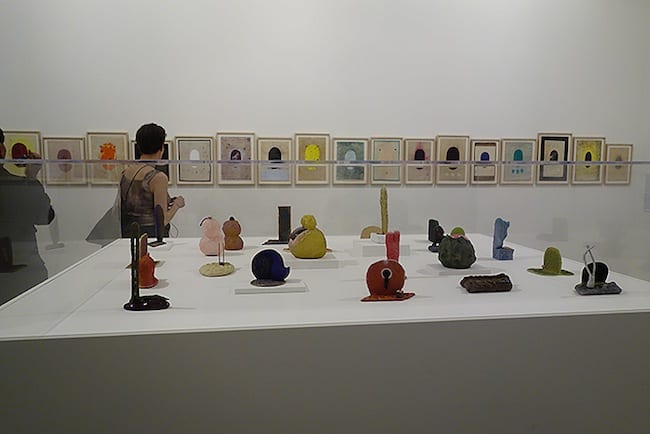It was a stroke of genius on the part of the 55th Venice Biennale’s curator, Massimiliano Gioni, to pair 30 of Ron Nagle’s sculptures with anonymous Tantric Paintings from different parts of Rajasthan, India made between 1966-2004. They were installed in the Giardini Main Pavilion and made a strong case for Massimiliano’s exhibition theme and title, The Encyclopedic Palace. The chemistry is gentle, as the two seem to sing gently to each other. Though the paintings are very different from Nagle’s own two-dimensional style (his drawing are didactic silhouettes of his sculptures) they merge effortlessly with his pop aesthetic and share an adventurous, inventive palette. “This is my big crossover,” Ron Nagle told Art in America from his studio in San Francisco during a telephone interview with Zoe Larkins.
The following text is an excerpt from the resulting article. CFile has illustrated it with casual photographs of the installation by viewers of the Biennale that capture something of the spirit of attendance. A few examples of Nagel’s work from the Biennale and later pieces, exquisitely photographed, have been added to show the visual rapture that Nagle is able to conjure in his medium.
Nagle joked about his career as a ceramist with AiA, describing himself and those of his contemporaries who also worked in clay as second-class citizens of the art world. As Zoe Larkins writes, “Nagle first experimented with ceramics as a high school student in San Francisco, and it was less than a decade later that he was showing with Peter Voulkos, Ken Price, and John Mason, among others known for their unorthodox methods of working with clay in postwar California. Curators and critics at the time celebrated ceramics, but in medium-specific shows that isolated artists like Nagle from their peers who worked in other media, namely paint. Inclusion with the 157 other artists in Gioni’s global exhibition is “just thrilling” for Nagle.
Nagle approached ceramics with refreshed interest when he was a student at San Francisco State University, after becoming familiar with the large abstract vessels that Voulkos was making in Los Angeles. Nagle entered college as an English major, making jewelry and small objects in metal as a hobby, before switching to the school’s BFA program. By the early 1960s, he was teaching at the San Francisco Art Institute and, not long after, at Berkeley, with Voulkos. (Nagle returned to the Art Institute in the ’70s.) At the same time, his work was included in seminal group shows with other ceramists at museums and galleries in California and around the world; he had his first solo exhibition in 1968 at San Francisco’s Dilexi Gallery.
Gioni’s show is based on an idea that self-taught artist Marino Auriti, who emigrated to Pennsylvania from Italy in the 1930s, had for a museum to showcase “all the works of man in whatever field, discoveries made and those which may follow,” which he called Il Enciclopedico Palazzo del Mondo, or the Encyclopedic Museum of the World. Gioni has adopted Auriti’s title for his exhibition, which he has described as a display of “artworks and figurative expressions that reveal approaches to visualizing knowledge through representations of abstract concepts and manifestations of supernatural phenomena.” Of the 30 pieces at the Biennale, some seem to model fantastical terrains; others could be talismans or renditions of alien life forms.
Each of his ceramic pieces begins as a drawing, Nagle said, and he tries to maintain an element of two-dimensionality once he begins modeling a drawing in three dimensions. “I have an obsession with profiles because I really want [the figures] to feel like drawings,” he said, and described his admiration of the way Giorgio Morandi and Philip Guston represent three-dimensional objects in two dimensions. “Everything is done, even subconsciously, from a flat point of view,” he said.
Text by Zoe Larkins for Art in America, published May 30th, 2013
Above image: Installation view of Ron Nagle sculptures with anonymous Tantric Paintings from Rajasthan, India at the 2013 Venice Biennale. Courtesy of the artist and Pierre-Marie Giraud Gallery, Brussels.






Installation views of Ron Nagle sculptures with anonymous Tantric Paintings from different parts of Rajasthan, India at the 2013 Venice Biennale. Courtesy of the artist and Pierre-Marie Giraud Gallery, Brussels.

Ron Nagle Stink Line, 2013. 6 x 6.25 x 2.25 in.

Ron Nagle, Pastafairian, 2013. 4.75 x 5.5 x 4 in.

Ron Nagle, Umoo Chu Moo, 2013. 6.5 x 6.25 x 4.5 in.

Ron Nagle, PM Dom, 2013. 7 x 5 x 4 in.

Ron Nagle, Missile Tow, 2013. 5.25 x 6.25 x 5 in.

Ron Nagle, Grandfather Figure, 2013. 2.5 x 6.25 x 5.25 in.

Ron Nagle, Seminole Figure, 2012. 9.7 x 4.2 x 3.2 in.

Ron Nagle, Seminole Figure, 2012. 9.7 x 4.2 x 3.2 in. All images courtesy of the artist and Pierre-Marie Giraud Gallery, Brussels.
Read the full interview in Art in America
Visit the Pierre-Marie Giraud Gallery, Brussels

Very nice write-up. I certainly appreciate this site. Keep it
up!
Thank you for any other informative web site.
The place else could I get that type of info written in such an ideal manner?
I have a undertaking that I’m simply now working on, and I have been on the glance out for such information.
Nice cap on beautiful woman in background of “Rotting Orange Surprise Dripping Licorice”
Thanks. Going to throw away everything in our fridge’s fruit crisper until we can purge that mental image.